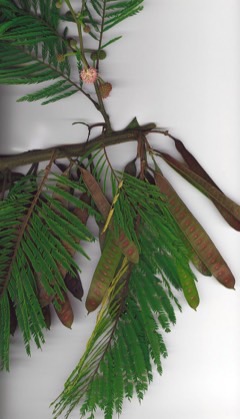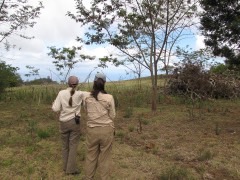 |
|
Forest Starr & Kim Starr starrenvironmental.com |
 |
| Forest Starr & Kim Starr starrenvironmental.com |
Translate this page:
Summary
The correct name is Leucaena diversifolia (Schltdl.) Benth.
Physical Characteristics

 Leucaena diversifiolia is a deciduous Tree growing to 15 m (49ft) by 15 m (49ft) at a fast rate.
Leucaena diversifiolia is a deciduous Tree growing to 15 m (49ft) by 15 m (49ft) at a fast rate.
See above for USDA hardiness. It is hardy to UK zone 10. The plant is self-fertile.
It can fix Nitrogen.
Suitable for: light (sandy), medium (loamy) and heavy (clay) soils, prefers well-drained soil and can grow in nutritionally poor soil. Suitable pH: mildly acid, neutral and basic (mildly alkaline) soils and can grow in very acid soils.
It can grow in semi-shade (light woodland) or no shade. It prefers moist soil.
UK Hardiness Map
US Hardiness Map
Synonyms
Acacia diversifolia Schltdl.
Plant Habitats
Edible Uses
References More on Edible Uses
Medicinal Uses
Plants For A Future can not take any responsibility for any adverse effects from the use of plants. Always seek advice from a professional before using a plant medicinally.
None known
References More on Medicinal Uses
The Bookshop: Edible Plant Books
Our Latest books on Perennial Plants For Food Forests and Permaculture Gardens in paperback or digital formats.

Edible Tropical Plants
Food Forest Plants for Hotter Conditions: 250+ Plants For Tropical Food Forests & Permaculture Gardens.
More

Edible Temperate Plants
Plants for Your Food Forest: 500 Plants for Temperate Food Forests & Permaculture Gardens.
More

More Books
PFAF have eight books available in paperback and digital formats. Browse the shop for more information.
Shop Now
Other Uses
Fodder
Agroforestry Uses: The plant has proved to be effective in controlling soil erosion[303 ]. It is also planted in reforestation schemes for soil amelioration and stabilization[303 ]. Its light crown, and ability to fix atmospheric nitrogen, makes it an ideal species for shade over perennial crops such as coffee[303 ] The annual leaf dry matter production can reach 10 - 16 tonnes/hectare. When incorporated as green manure, this adds 72 - 119 kg nitrogen, 2.5 - 3 kg phosphorus, 29 - 60 kg potassium, 47 - 94 kg calcium and 7.5 - 18.5 kg magnesium to the soil per hectare[303 ]. Other Uses A water-soluble gum is obtained from the plant[303 ] It contains the sugar rhamnose[303 ]. Sufficiently large logs are used in construction and as poles[303 ]. The pulp is desirable for paper production[303 ]. One of the primary uses of the species is firewood and charcoal; its energy value is 900-19 300 kJ/kg[303 ].
Special Uses
Carbon Farming
References More on Other Uses
Cultivation details
Agroforestry Services: Alley crop Agroforestry Services: Contour hedgerow Agroforestry Services: Crop shade Agroforestry Services: Nitrogen Fodder: Bank Management: Coppice Management: Standard Minor Global Crop
Succeeds in moist tropical and essentially frost-free subtropical areas at elevations up to 1,740 metres[303 ]. It grows in areas where the mean annual temperature ranges from 18 - 30°c, and the mean annual rainfall is 600 - 3,500 mm, with 0 - 4 months dry period[303 ]. The natural distribution of L. Diversifolia corresponds to a narrow zone of moist or very moist submontane evergreen forest, subject to frequent mist and cloud cover[303 ]. It also grows sometimes abundantly in secondary vegetation. As a mid-elevation species, it is tolerant of cool climates but not frost[303 ]. Grows best in a sunny position but tolerates some shade[418 ]. Prefers slightly acid, fertile soils but is tolerant of leached soils[303 ]. The aggressive nature and profuse growth occasionally make it a weed[303 ]. The plant is self-fertile; it flowers and fruits over an extended season and sets prodigious quantities of seed from an early age. In other words, it has all the traits to make it an aggressive colonizer of ruderal sites and secondary or disturbed vegetation in many places[303 ]. This species has a symbiotic relationship with certain soil bacteria, these bacteria form nodules on the roots and fix atmospheric nitrogen. Some of this nitrogen is utilized by the growing plant but some can also be used by other plants growing nearby[200 ].
Carbon Farming
-
Agroforestry Services: Alley crop
Integrates annual crops with rows of perennials.
-
Agroforestry Services: Contour hedgerow
Alley cropping systems on the contour of slopes.
-
Agroforestry Services: Crop shade
Plants providing crop shade especially trees.
-
Agroforestry Services: Nitrogen
Plants that contribute to nitrogen fixation include the legume family – Fabaceae.
-
Fodder: Bank
Fodder banks are plantings of high-quality fodder species. Their goal is to maintain healthy productive animals. They can be utilized all year, but are designed to bridge the forage scarcity of annual dry seasons. Fodder bank plants are usually trees or shrubs, and often legumes. The relatively deep roots of these woody perennials allow them to reach soil nutrients and moisture not available to grasses and herbaceous plants.
-
Management: Coppice
Cut to the ground repeatedly - resprouting vigorously. Non-destructive management systems maintaining the soil organic carbon.
-
Management: Standard
Plants grow to their standard height. Harvest fruit, seeds, or other products. Non-Destructive management systems.
-
Minor Global Crop
These crops are already grown or traded around the world, but on a smaller scale than the global perennial staple and industrial crops, The annual value of a minor global crop is under $1 billion US. Examples include shea, carob, Brazil nuts and fibers such as ramie and sisal.
References Carbon Farming Information and Carbon Sequestration Information
Temperature Converter
Type a value in the Celsius field to convert the value to Fahrenheit:
Fahrenheit:
The PFAF Bookshop
Plants For A Future have a number of books available in paperback and digital form. Book titles include Edible Plants, Edible Perennials, Edible Trees,Edible Shrubs, Woodland Gardening, and Temperate Food Forest Plants. Our new book is Food Forest Plants For Hotter Conditions (Tropical and Sub-Tropical).
Shop Now
Plant Propagation
Seed - requires pre-treatment to allow water to penetrate the hard coat. This can be done by carefully abrading part of the seed coat, being careful not to damage the seed. Alternatively, soak the seeds in a small quantity of almost boiling water, which cools down quickly enough so that it does not cook the seed. Then soak the seed for 12 - 24 hours in warm water prior to sowing. Treated seeds can give 70% germination within one week[303 ]. Typically, seedlings should be transplanted into the field 8 - 12 weeks after germination[303 ]. Seed storage behaviour is orthodox; viability can be maintained for several years in hermetic storage at room temperature with 5 - 8% mc[303 ]. Vegetative propagation from cuttings and grafts has generally failed, although tissue culture is successful[303 ].
Other Names
If available other names are mentioned here
Local Common Names Guatemala: chalíp; gnash Jamaica: wild tamarind Mexico: guache; guaje; guaje blanco; guaje del río; guajillo; guashí; sashíbte; Shasíb
Native Range
Coming Soon
Weed Potential
Right plant wrong place. We are currently updating this section.
Please note that a plant may be invasive in one area but may not in your area so it's worth checking.
The aggressive nature and profuse growth occasionally make it a weed[303 ]. L. diversifolia and its hybrid with L. leucocephala are aggressive colonizers of ruderal sites and secondary or disturbed vegetation in Mexico (the native range).
Conservation Status
IUCN Red List of Threatened Plants Status : This taxon has not yet been assessed

Growth: S = slow M = medium F = fast. Soil: L = light (sandy) M = medium H = heavy (clay). pH: A = acid N = neutral B = basic (alkaline). Shade: F = full shade S = semi-shade N = no shade. Moisture: D = dry M = Moist We = wet Wa = water.
Now available:
Food Forest Plants for Mediterranean Conditions
350+ Perennial Plants For Mediterranean and Drier Food Forests and Permaculture Gardens.
[Paperback and eBook]
This is the third in Plants For A Future's series of plant guides for food forests tailored to
specific climate zones. Following volumes on temperate and tropical ecosystems, this book focuses
on species suited to Mediterranean conditions—regions with hot, dry summers and cool, wet winters,
often facing the added challenge of climate change.
Read More
Expert comment
Author
(Schltdl.) Benth.
Botanical References
Links / References
For a list of references used on this page please go here
A special thanks to Ken Fern for some of the information used on this page.
Readers comment
| Add a comment |
|
If you have important information about this plant that may help other users please add a comment or link below. Only comments or links that are felt to be directly relevant to a plant will be included. If you think a comment/link or information contained on this page is inaccurate or misleading we would welcome your feedback at [email protected]. If you have questions about a plant please use the Forum on this website as we do not have the resources to answer questions ourselves.
* Please note: the comments by website users are not necessarily those held by PFAF and may give misleading or inaccurate information.
To leave a comment please Register or login here All comments need to be approved so will not appear immediately.
|
Subject : Leucaena diversifiolia
|
|
|
|